Evaluating trends is vital in innovation as it allows businesses to anticipate and adapt to changing market demands and technological advancements. Companies can use trend analysis to develop innovative products and services that meet current and future customer needs, ensuring their offerings remain relevant and competitive. This strategic approach to innovation, grounded in market trend analysis, is key to sustaining growth and staying ahead in dynamic industries.
This blog presents ten factors to help you evaluate new, nascent, and emerging trends in your business environment. From market potential to competitor response, this guide offers a comprehensive framework for analyzing trends using current and historical data to identify opportunities and inform business decisions.
How to evaluate trends in your business environment
Evaluating market trends according to different internal and external factors provides a central view of the perceived impact that relevant drivers may have on your company’s future growth plans. To analyze trends in your business environment, consider these steps in the ITONICS Innovation OS:
- Centralize: Organize market research and trend data in the Innovation OS. Segment and contextualize your trends in the Trend Radar for a single, dynamic view.
- Enrich: Add further context with tags and relations. Disseminate trends within your organization, encouraging engagement and enrichment from experts.
- Rate: Define trend rating criteria and invite responsible evaluators to collaboratively rate all or a selection of trends in the Innovation OS.
- Track: Gauge the evolution of your trends by continuously monitoring related signals, interest over time, and key events using Automated Monitoring.
- Analyze: Systematically assess the influencing factors and implications of each trend, prioritizing the need for action based on a holistic evaluation.
- Act: Develop and implement action plans based on the trend analysis. Trends often inform future scenarios and opportunity spaces for exploration in ideation.
By evaluating the trends in your innovation ecosystem, you can derive valuable insights to inform strategic decisions and shape your company's future growth strategy. Given the uncertainty of future events, this comprehensive approach ensures that your business remains agile, forward-thinking, and aligned with evolving market dynamics.
10 factors to consider for evaluating trends
1. Trend domain
This factor is important for providing context and an initial understanding of a trend’s presence in the market. Consider the macro-environmental dimensions where the trend has or will have the greatest impact. You can use the STEEP framework to categorize trends into social, technological, economic, environmental, or political dimensions. This categorization also guides foresight managers in disseminating and assigning trends to responsible teams or experts. For instance, trends categorized as political may be most relevant for regulatory and compliance teams within an organization.
2. Trend scope
While STEEP describes where the impact is occurring, scope evaluates how far-reaching a trend's potential impact or influence is in the current market. This could consider how the trend is perceived globally or in specific regions, as well as whether its impact extends to multiple industries or just a specialized sector. Understanding the scope helps businesses align their strategies appropriately. A trend with a global, cross-industry impact might require a more comprehensive strategic approach than a trend with a limited, niche impact.
In the ITONICS Innovation OS, the Trend Radar is segmented by STEEP dimensions for easy navigation. Trends are also pre-configured with a rating criterion for scope. Curated trends in the ITONICS Showroom are pre-rated using our evidence-based methodology. Using data from ITONICS Insights, we measure occurrences of keywords associated with each trend and technology across three dimensions: signals, industries, and regions. From the relevant data, we derive a weighted mean value to indicate the overall Scope.
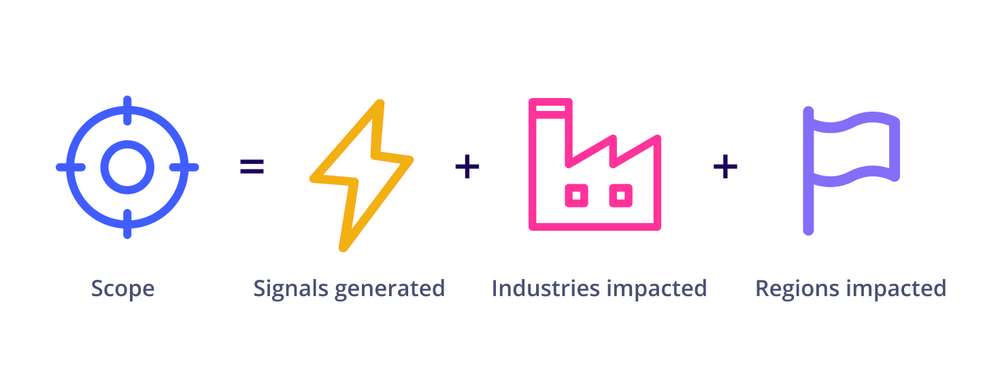
3. Market potential
Market potential looks at a trend’s economic indicators to understand how adopting or responding to it could impact your company’s revenue or cost savings. This factor could include market size, profitability, and potential impact. Of these, Potential Impact is one of the most commonly used metrics in evaluating a new trend, particularly from a financial and economic perspective. By estimating the current and projected size of the market that the trend affects, foresight managers can begin to formulate a deeper understanding of how much of that market their company could realistically capture through innovation.
4. Time-to-market
Time-to-market in relation to trends refers to the period it takes for a trend to have a substantial impact on the market. It is influenced by factors like market readiness and demand, technological advancements, and the regulatory environment, among others. Time-to-Market Impact is crucial in evaluating how quickly a business should respond to a trend and bring relevant products or services to market. This measure helps businesses understand the urgency and feasibility of adopting a trend. Generally, fast-paced trends have a shorter time-to-market impact, whereas more gradual trends have a longer time-to-market.
You can use the Gartner Hype Cycle to provide additional context when assessing time-to-market. For instance, trends at the Peak of Inflated Expectations may require a swift time-to-market response to capitalize on the hype, but with the awareness that the trend might not have long-term viability. Meanwhile, trends in the Trough of Disillusionment may not be ripe for immediate market entry but could be promising for long-term investment.
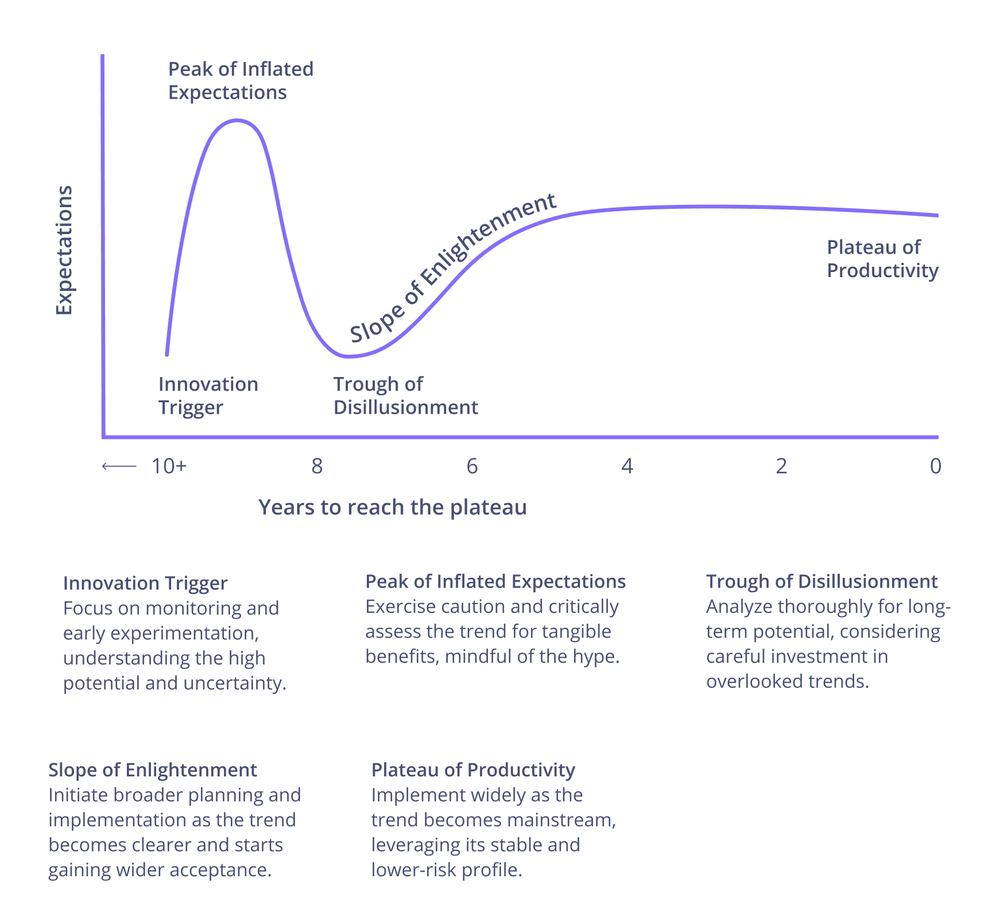
5. Maturity level
Trends typically go through various stages of development or maturity: emerging, improving, mature, and aging. Understanding the Adoption Stage helps companies decide which trends to adopt, when, and how to align them with their business strategies. For instance, early adoption of emerging trends can position a company as a leader and innovator—at higher risk but potentially higher rewards—while adopting mature trends can reinforce stability and reliability. This factor can also inform resource allocation as emerging or improving trends may require more R&D investment, whereas mature trends may need more focus on optimization and efficiency.
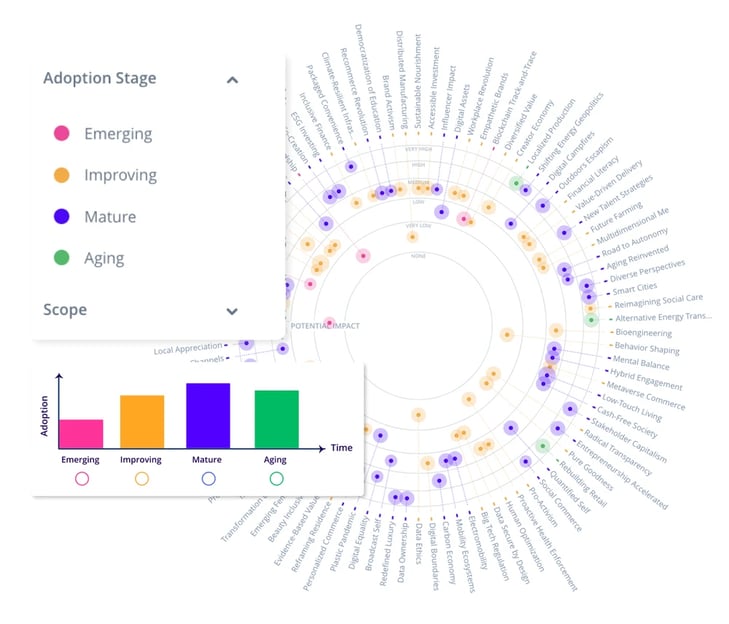
6. Velocity of change
Understanding a trend’s speed of change is important in informing your company’s need for action. However, rather than looking at speed alone, velocity is a far more meaningful factor for trend analysis. Velocity is speed plus direction, where direction refers to the nature and trajectory of a trend—whether it is growing, declining, or evolving in a particular way. For instance, a trend might be moving from a niche market to mainstream acceptance or vice versa. Therefore, it is this more contextualized measure of velocity that is a key factor in ensuring that your business strategy is proactive rather than reactive, aligning with the dynamic nature of market trends.
With automated monitoring and smart scoring in the Innovation OS, you can easily evaluate a trend’s velocity and evolution based on the number of related signals over time. Powered by artificial intelligence, the system consolidates signals from news, patent data, and publications, assigning a score based on the nature and importance of observed changes. This score appears as a trend rating criterion, Speed of Change, calculated over periods of 90 or 180 days. It also indicates key events that correspond with sudden or sustained spikes or declines in the number of signals over the same period (i.e., the direction of change).
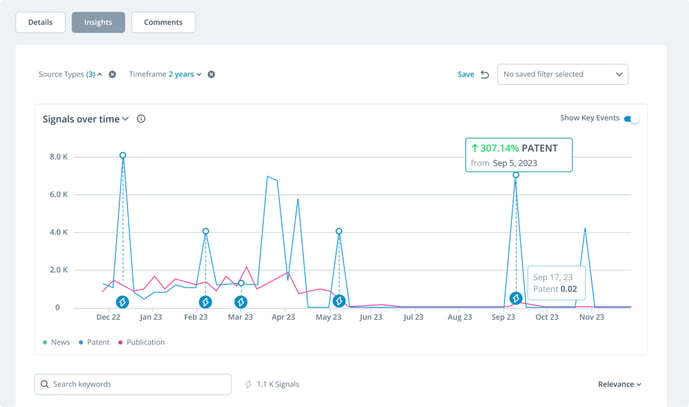
7. Interrelatedness in innovation ecosystem
How a trend is related to and interacts with other elements in your innovation ecosystem provides a holistic view for better strategic decision-making. A trend’s relationship to other trends, as well as technologies, opportunities, ideas, projects, etc., can help you comprehend the broader impact of a trend, identifying patterns, synergistic opportunities, and potential challenges. This analysis ensures that trend adoption is aligned not only with current business needs and initiatives but also with emerging opportunities and future growth trajectories. Identifying and making sense of trend relations requires that your innovation ecosystem serves as a single point of truth, centralizing and intelligently organizing all your innovation information and activities.
The Innovation OS instantly visualizes relations and dependencies between trends and other elements in your innovation ecosystem. Relations are visible on the Radar, Network Graph, and element detail pages. In addition, the smart Recommended Relations tool uses machine learning to automatically suggest relevant tags, related elements, and experts within your ecosystem to speed up trend evaluation and strategic decision-making.
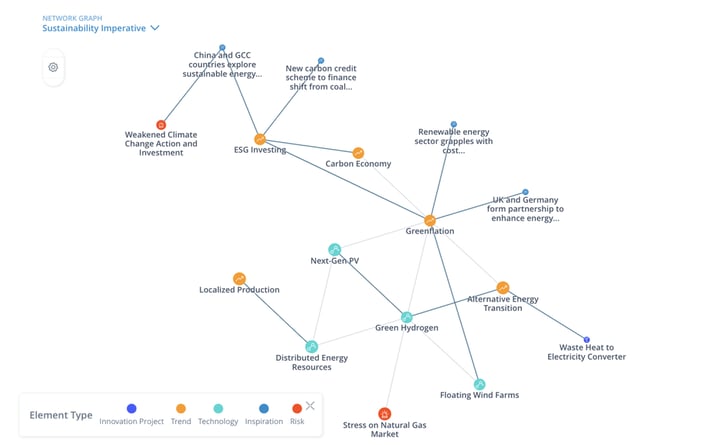
8. Competitor response
Evaluating how competitors in your industry are reacting to or adopting a trend provides insight into market dynamics, possibly highlighting a competitive advantage or threat. Conducting market research, monitoring competitor activities like patents and communications, and analyzing industry publications are ways to evaluate the competitor's response to a trend. Understanding the level of adoption, investment, and innovation competitors are directing toward a trend enables more informed strategic planning and positioning.
9. Relevance to business goals
Evaluating a trend's relevance to business goals helps prioritize trends that are not just popular according to consumer perception but are genuinely beneficial for your company's long-term success and growth, thus maximizing resource utilization and market positioning. It also aids in avoiding misalignment with company culture or customer needs, enhancing overall business performance and strategic direction. It can comprise multiple criteria, including business relevance (how the trend aligns with the company's current operations and immediate objectives) and strategic fit (how well the trend aligns with the company's long-term goals and strategic plans).
Determine a trend’s relevance to your business goals by inviting subject matter experts and stakeholders to collaboratively rate trends in your business environment on the criteria of Business Relevance and Strategic Fit. Remember that business relevance speaks more to operational and near-term goals, while strategic fit looks at strategic, long-term goals. Combining these ratings in the Matrix gives you a comprehensive visualization of how a trend aligns with your company’s core objectives and vision for the future, thereby informing the need for action.
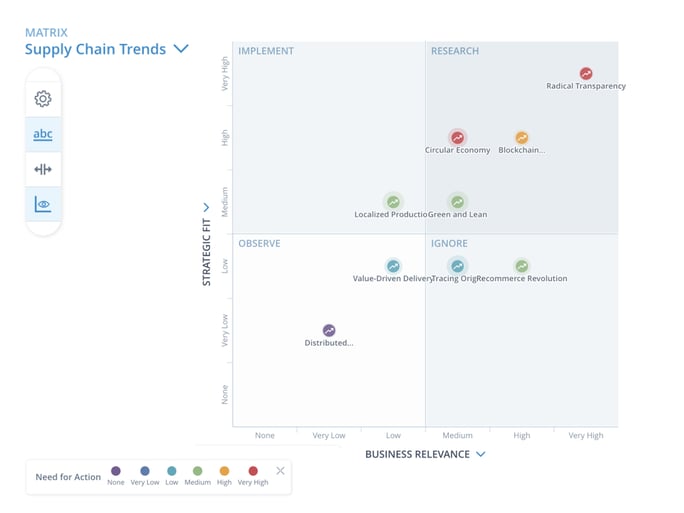
10. Need for action
Need for Action involves determining the urgency and importance of responding to a specific trend. It's essential because it helps prioritize resources and focus on trends that offer significant opportunities or pose considerable risks for your organization. This factor is typically attributed by analyzing the holistic outlook of a trend, involving some, if not all, of the factors listed above. It should also consider multiple stakeholders’ input and diverse perspectives—possibly from internal and external technical experts, leadership, and customers. This process reduces bias and blindspots in decision-making around whether to adopt, adapt, or monitor a trend going forward.
Best practice in trend management: foresight at Dolby
Leading American audio and imaging technology company Dolby Laboratories has developed a best practice in strategic foresight and trend management using the ITONICS Innovation OS. ITONICS allows Dolby’s Futures Council to systematically identify, monitor, and evaluate global signals and emerging trends.
By introducing a more structured and efficient trend management and trend analysis framework, Dolby can quickly connect the dots and prioritize the trends with the highest potential impact and alignment with its goals and strategy. Supported by real-time and historical data with AI-based signal monitoring, the Innovation OS allows Dolby to predict future trends and adapt quickly to market dynamics to maintain leadership at the forefront of the audiovisual technology sector.
Use market trends to inform strategic decision-making
Trend evaluation is a critical component of successful innovation. It enables businesses to stay ahead of market changes, adapt to new opportunities, and avoid potential risks. Through trend evaluation, companies can align their innovation strategies with emerging market needs, consumer behavior, and technological advancements. This not only fosters a culture of proactive adaptation but also ensures that innovations remain relevant and competitive.
Transform your company’s trend management with the ITONICS Innovation OS. The Innovation OS offers a suite of trend analysis tools, including:
- Trend Radar for visualizing, contextualizing, and comparing trends in dynamic views to understand potential impact at a glance.
- Automated Monitoring to track the evolution of signals related to a trend using real-time external data.
- Collaborative ratings enabling teams to rate and enrich trends for more informed decisions and consensus.
- Matrix view for analyzing trends to identify high-potential business opportunities and support data-driven decisions.
- Network graph to find patterns and dependencies between trends and other elements in your innovation ecosystem.
Build strategic business intelligence and make more informed decisions about your future market position and how to achieve it using the #1 AI-driven Innovation OS. For trends, technologies, opportunities, ideas, innovation projects, and more.



/Assets%20and%20Heros/nav-thumbnail-Gartner.webp?width=150&name=nav-thumbnail-Gartner.webp)








.webp??&width=379&height=288&name=header-technology-radar-2%20(1).webp)